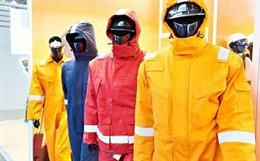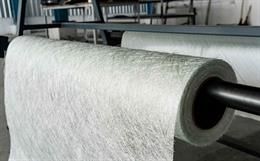Sustainable goals suggest longer-lasting products should be the priority, yet in the past few years in the nonwovens industry, single-use products have made all the gains.
The applications for nonwoven fabrics fall roughly into two broad categories – those for disposable end-uses and those employed in more durable applications.
While the period since the start of the COVID-19 pandemic has not been without difficulty for any business, nonwoven manufacturers serving the markets for disposable products have generally fared better than those providing more durable products – and in some fields received a significant boost.
AHPS
Absorbent hygiene products (AHPs) are the key category for disposable nonwovens and constitute an industry which was worth around $120 billion at retail in 2021. This is comprised of baby diapers, a $65 billion market, feminine care (femcare) products – sanitary pads, panty liners etc – a $40 billion market, and those for coping with adult incontinence (AI), worth an annual $15 billion, and growing rapidly. COVID-19 only boosted sales of all of these products in 2020 and 2021, initially through panic and bulk buying around the world, on top of already annually growing sales averaging 5 per cent per year.
The AHP industry’s highly globalised structure – with most of its major players having uniform manufacturing operations which are evenly distributed across continents for close-to-customer supply – allowed it to evade many of the supply chain disruptions that have subsequently arisen.
Significant new spunmelt capacity for AHPs also came onto the market in 2020 and 2021, with start up before the end of 2022, after a lull in investments during 2018 and 2019.
The growth of regional AHP markets has been in parallel with the rising wealth of countries, as is illustrated by China – which in 2021 consumed some 42 billion baby diapers – over the past 25 years. This is reflected in nonwovens production figures. China’s nonwovens industry back in 1997 amounted to just 228,000 tons –182,000 tons of drylaid products and 46,000 tons of spunmelt materials. In 2021, the country’s nonwovens production was 8.8 million tons, consisting of 4.5 million tons of drylaid nonwovens and 4.5 million tons of spunmelt, according to the China Nonwovens and Industrial Textiles Association (CNITA). This equates to a CAGR of +15 per cent for the last 24 years.
Wipes
Another nonwoven-based product group often manufactured and sold by the same AHP consumer brands is that of disposable wipes. This market is worth $20.82 million in 2022 and will grow at a CAGR of 6.8 per cent to be worth $28.95 million in 2027, according to a recent report from analyst Smithers.
Baby wipes remain the largest single segment of this market (48.4 per cent of the total) and sales of disinfecting, antibacterial and healthcare wipes surged during 2020 and 2021.
On top of the pandemic and supply chain issues, manufacturers of disposable wipes and their suppliers faced a major challenge in 2021 with the introduction of the European Union’s Single-Use Plastics Directive (SUPD).
Both nonwoven wipes and feminine hygiene products were included on the SUPD list of the ten products most commonly found discarded on European beaches. In July 2021 the legislation came into force, requiring any such plastic-containing products to carry prominent warning labels, with extended producer responsibility (EPR) scheduled to come into place in December 2024 for their clean-up, collection and disposal.
Naturally, this negative branding and potential additional taxation was something brands wanted to avoid at all costs, resulting in much work on the development of both new wipes and feminine hygiene products based on alternatives to petroleum-based plastics to avoid the labelling and additional costs.
Even as such technologies were being trialled and tested in preparation for the SUPD, COVID-19 ensured that consumer priorities and the demand for products changed virtually overnight, catching both suppliers and supply chain manufacturers completely off guard.
Disinfecting wipes, for example, were suddenly an essential item on shopping lists, while the need for skin care and make-up wipes dropped off significantly as workers stayed at home. Many new product formats evolved as brands scrambled to cope with the shifting demand.
Adding a further complication, it was unclear until a very late stage that cellulosic fibres like viscose and lyocell would even escape being defined as plastics by the EU’s accepted definition.
During 2021, many nonwovens manufacturers made the switch from synthetics to 100 per cent cellulose fibres and manufacturing lines were repurposed and production schedules streamlined. Converters and brands too had to plan and carry out complete changes to product formulations and portfolios.
Even in normal circumstances this wouldn’t have been easy, but in the midst of a pandemic the challenges were magnified.
PPE
The growth of a further disposable nonwovens segment has already been well chronicled – the sudden and urgent need for facemasks and other PPE across the world since the beginning of the COVID-19 pandemic.
A key reason for the severity of the facemask shortages was the unavailability of specialised meltblown nonwoven filter media and prices for this fabric soared, followed by setting up of around 150 new stand-alone meltblown lines worldwide.
At the height of the pandemic, approximately 129 billion disposable facemasks were being used each month around the world.
Automotive
In more durable applications, nonwovens expanded rapidly in the automotive industry for many years as automakers and their component suppliers looked to decrease costs by reducing the weight of vehicles. The aim was to lower fuel consumption and CO2 emissions and comply with new legislation. As a result, the use of nonwoven fabrics in the European automotive industry alone grew by 11.3 per cent per year between 2010 and 2015, despite the fact that the production of cars and light vehicles in Europe grew by only an average 1.3 per cent annually in the same years.
While this growth has now slowed, it underlines just how much nonwovens have already been included in the lightweighting designs of vehicle manufacturers and reveals that a good deal of material substitution has already taken place in conventional internal combustion engine (ICE) vehicles.
Nonwovens do, however, have an equally significant role to play in the fast-accelerating transition to electric vehicles (EVs) and alternative methods of propulsion, but the automotive industry in general has not fared well since the beginning of the COVID-19 pandemic.
The global production of cars and light vehicles was 91.7 million in 2019 according to the Paris-based OICA (Organisation Internationale des Constructeurs d’Automobiles – the International Organisation of Motor Vehicle Manufacturers) and fell to 77.6 million in 2020.
A bounce back in 2021 was not as high as was anticipated and the 80.1 billion cars and light vehicles produced represented just a 3 per cent increase. The industry has been significantly affected by supply chain issues, raw material shortages and in particular, the shortage of supercapacitors.
Despite this, a big application for nonwovens in ICE vehicles is still in insulating materials for absorbing the noise of the engine and dampening the vibrations caused by it. Many of these are superfluous in EVs, but at the same time, other noises are helpfully masked by an engine.
As a result, sound reduction becomes even more critical for EVs because external as well as internal sources such as fans, pumps and electronic drive components are more audible. There are additional thermal challenges too – without waste heat from the engine, the passenger cabin of an electric vehicle can be significantly chillier than that of a conventional vehicle, which calls for different insulating solutions.
Geotextiles
Another key market for durable nonwovens is geotextiles. This market has also suffered through stalled infrastructure projects over the past couple of years but is expected to grow at around 7 per cent annually over the next few years.
Around 750,000 square metres of nonwoven geotextiles are sold each year according to EDANA (the European Disposables and Nonwovens Association) – the equivalent of 185,000 football fields – with 60 per cent employed in the construction of roads.
These nonwovens – primarily densely-needled or spunbonded materials based on polypropylene or polyester – are part of a family of geosynthetics that today includes woven fabrics, geocells, geofoams, geogrids, genonets, geomembranes and a number of other specialised materials.
To meet the needs of global construction projects, the leading manufacturers are increasingly providing these materials in multi-layer combinations to solve specific functional requirements.
In addition to roads, geosynthetics are used extensively in the construction of railways, retaining structures, embankments, tunnels, pipelines and landfills. In addition, they are employed in coastline protection works and marine structures, while wastewater treatment in mining and the upstream oil and gas sectors is a key area of growth.
The functions they can provide include materials separation, filtration, drainage, soil reinforcement, erosion control, sealing, stress relief, adhesive bonding, confinement and monitoring.
In addition to the speeding-up of construction processes and cost advantages, when compared to simply using natural soils, geosynthetics also have a much lower environmental impact. This reduces both CO2 emissions and the need for excavations in quarries or in other environments.
A key element in many construction projects, meanwhile, is accommodating challenging terrain that requires walls and steep slopes. Here, geogrids and geotextiles often work in concert with soils to construct safe, resilient and long-lasting surfaces. They are also used to achieve varied geometries and the desired aesthetic appearance. In addition, they can be used with locally-formed soils which cuts down the need for shipments of construction materials to a site considerably.
The European Commission (EC), however, is currently carrying out an impact assessment study to ascertain how responsible these geotextiles are for the release of microplastics.
“I think it’s quite obvious that if you put huge quantities of plastic-based products into the environment in sometimes very harsh conditions, the erosion and abrasion they’re subjected to will lead to microplastics release,” said Werner Bosman, circular economy policy officer for the EC’s Environment Directorate at a recent EDANA meeting in Brussels. “The question is, if geotextiles are responsible for microplastics release, what can we do about it? Are there alternatives, and are the alternatives good enough? We are currently working to come up with solutions.”
In response, the International Geosynthetics Society (IGS) called on the EC to fully understand the enormous sustainability benefits of geosynthetics and ensure that this important issue is addressed using the best available scientific data and case studies.
It has also called on the EC to fully consider the entire lifecycle benefits of all products that use synthetic materials in their manufacture.
It is inappropriate to compare single-use consumer plastics, which decompose rapidly and are often disposed of irresponsibly, with high-quality durable engineering products that deliver long-lasting benefits to entire communities, the IGS says. Geosynthetics present a negligible environmental risk, and where risk exists at all, it is a rare occurrence within the highly regulated disciplines of civil and environmental engineering. Potential examples such as the use of incorrectly specified products or misguided installation and maintenance practices are addressed through high technical and professional standards in the industry.
“Geosynthetics deliver enormous benefits,” says Preston Kendall, co-chair of the IGS Sustainability Committee. “They reduce freshwater losses from irrigation canals in water-stressed regions and play a critical role in water and wastewater treatment plants. Compared to other construction materials, their carbon footprint is typically 65 per cent lower. They protect lives and livelihoods by reinforcing slopes and underpinning vital infrastructure. Geosynthetics offer a durable, reliable and resource-light means to protect vulnerable coastal zones from erosion. They also help to contain millions of tons of plastics stored in landfill every year.”
According to Francesco Fontana, chair of the IGS Corporate Committee, independent data shows that most plastic waste entering the environment is a result of poor waste management. The EC’s own figures estimate that vehicle tyres and road markings (55 per cent), pellets (28 per cent) and clothing textiles (8 per cent) account for the majority of microplastics in marine environments. Single use consumer plastics such as carrier bags and plastic bottles also contribute.
“In contrast to many consumer plastics, geosynthetics do not normally degrade and can be fully recovered and recycled at end of life,” Fontana said in conclusion.
It would be ironic if after all the attention that has been paid to the problem of single-use disposable nonwovens in the environment, durable products like geotextiles face new legislative obstacles going forward. This is surely unlikely given the tremendous benefits they bring to infrastructural projects worldwide.







